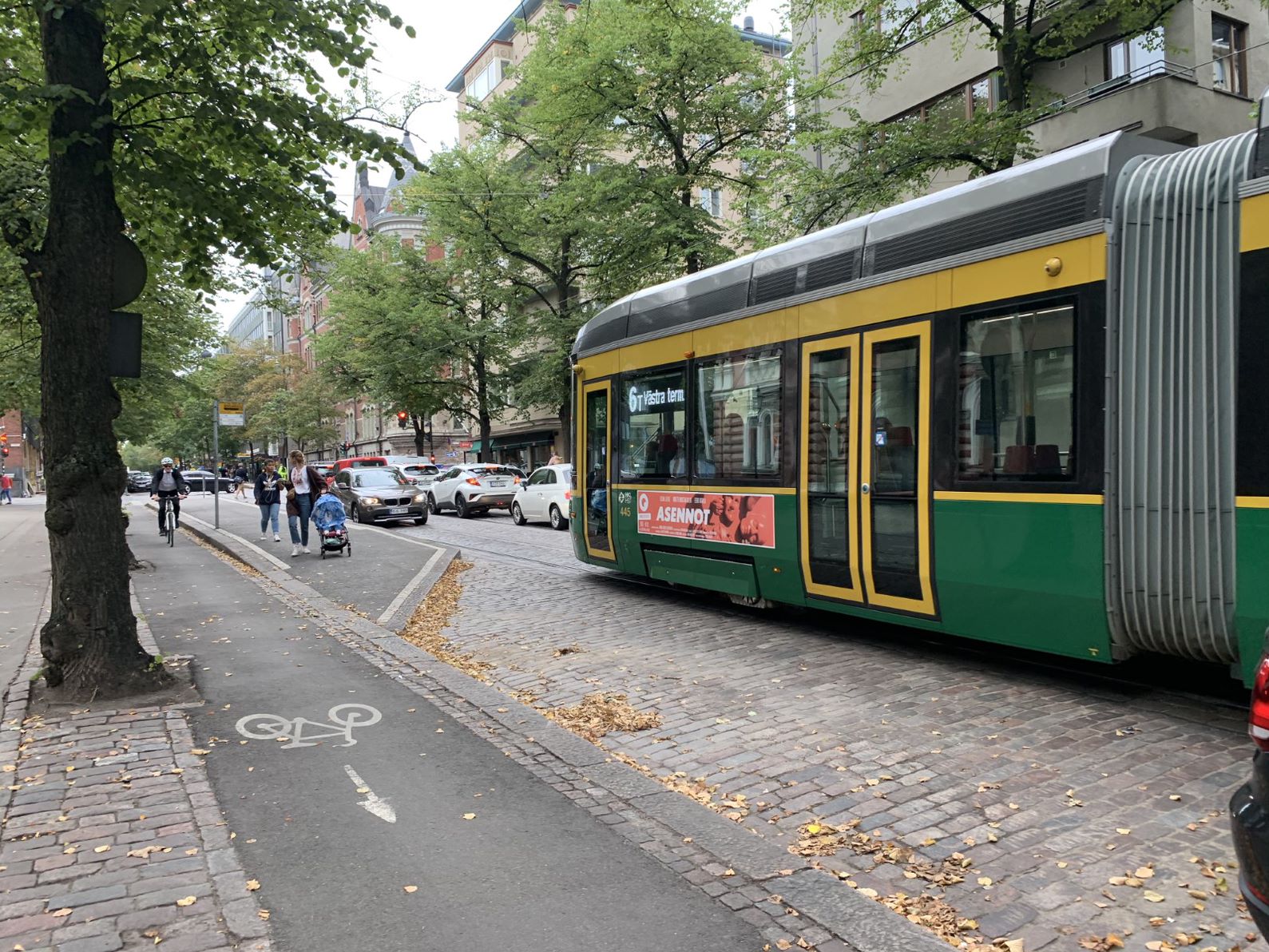As part of a fact-finding trip, I had the recent opportunity to visit Helsinki, Finland and Stockholm, Sweden. The experience of visiting these two cities is a great lesson for Cleveland illustrating how green and complete streets can provide major cultural and health benefits. Finland was recently ranked as having the happiest people on the planet and the recent articles about Helsinki’s approach to homelessness prompted this trip.
For some context, the Helsinki metropolitan area is about the size of Greater Cleveland with 1.3 million in it. It is also a cold weather city, colder than Cleveland, and is the world’s most northern metropolitan area with over a million people. It also has its own version of the Guardians of Transportation outside of the Helsinki Central Rail Station. The city’s annual budget is $5,400,000,000. Yes that’s 5.4 Billion. It’s also considered the ‘Honest City.’ An experiment a few years ago placed eleven wallets full of cash around the city, ten were returned to their owners with nothing missing. You’ll routinely see bicycles unlocked along the street.
One of the first things you’ll notice when you arrive in the city is the number of unaccompanied children. Boys and girls as young as five or six years old are on public transportation by themselves and walking to school. One Finnish person stated, “We want our kids to be as independent as possible from a young age to teach them life skills.”
Unlike Copenhagen, Helsinki didn’t have a very strong bicycle culture until a little over five years ago. Now almost every street is a complete street, with dedicated bicycle lanes. An abandoned freight rail line that used to go right through the central city now serves as the spine of a bicycle expressway network. Even in the rain the system is heavily used. Scooters were recently introduced and have been seamlessly integrated into the network. Even what is considered Finnish sprawl has a multipurpose path everywhere.
The Finnish people are considered to be quiet and while Helsinki’s urban noise isn’t anywhere close to an American city, there is still a strong desire to find quiet space. Kamppi Chapel, opened in 2012, is considered the silent chapel. Constructed right in the center square, similar to our Public Square, the inside of the church remains completely silent. No talking is allowed. Anyone can go in throughout the day and sit for as long as they like to reflect. The outside of the chapel is staffed during the day in case anyone does need someone to talk to or is in a crisis.
Finland, as an independent country, is only 101 years old. As a gift to themselves, the Finnish people built the Oodi – The Helsinki Central Library. Last year it was voted the best library in the world. People of all walks of life use the library daily and features meeting spaces that can be requested free of charge. The library is open until 10pm throughout the week.
After four days in the city, I hopped on a train, one of 400 departures daily from the city, to Joensuu, a city about four hours north of Helsinki. Joensuu is a university town with a population of 70,000, half of whom are student. Even in this town, not too far from the Russian Border, bikes are king. As you travel rural highways, you’ll also notice a multipurpose path along nearly stretch of the road.
After hiking in Koli National Park and exploring more of Joensuu, I had the opportunity to meet with students at several of the local universities. Most had never met an American before. Even though Finnish college is paid for by the state and students actually receive a stipend for living expenses, college students are remarkably similar to those in the states and always trying to save money. These students talked about on weekends they’ll often load their cars up with gas cans and drive to Russia to buy their very cheap gasoline.
The next stop was Stockholm, Sweden. When you arrive you’ll immediately notice how modern all of the infrastructure is. From the airport you’ll board the Alanda Express, a high-speed train that will take you from the airport to the city center in 18 minutes at 125mph.
Stockholm is a cyclist’s dream. There are dedicated bike paths everywhere and its not uncommon to almost get hit by a bicycle rather than a car if you’re not paying attention. There are more people on bikes and scooters at times than there are people walking. When talking with a Swedish friend of mine, she commented, “We’re very keen on how our daily activity affects our overall well-being.” Most Swedes prefer to ride a bike or walk because it allows them to be more in touch with nature.
One major lesson that Cleveland could learn from Stockholm is security. In 2017 a terrorist plowed a truck through long pedestrian market that in the middle of the city killing five people. The city responded by taking the small public art lions used around the city as benches and recasting them as concrete barriers at each block of the pedestrian mall. No jersey barriers.
Taking this trip was both refreshing and eye opening about the possibilities of our own great city. A few lessons learned:
Cold weather means nothing. Both Helsinki, Joensuu, and Stockholm both have harsher and colder winters than Cleveland. The only thing stopping us from being more active in the winter is the way we’ve physically made it impossible to get around.
Frame multi-modal transportation opens as a public health issue. Both the Finns and the Swedes commented how the preferred mode of transportation is almost always not the car. They feel better from both a physical and mental health aspect. Children are all walking or riding their bikes to school because there is not a danger to their physically wellbeing, which encourages them to be more independent.
Its never too late. While Stockholm’s cycling infrastructure is more mature, Helsinki just started its intensive program five years ago. Its why the project like the Midway on Superior Avenue is so important because it will jumpstart many of our other complete street projects.
Now, time to get back to work.
-Mark Lammon









